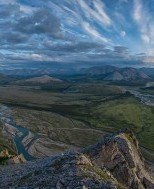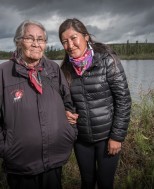Why Protect?
In a world where wilderness is becoming endangered, the Peel Watershed stands out. From its dramatic mountain peaks and high plateaus to its sprawling river valleys and wetland networks, the Peel is one of Canada’s natural wonders. Carving up this unspoiled land with roads, mining and fossil fuel development would mean surrendering one of the last remaining large and undisturbed watersheds on the planet. The reasons for protecting the Peel are many: environmental, social, historical, economic and moral.
At over 68,000 km2, the Peel is a northern wilderness rich in biodiversity, where caribou, grizzlies and wolves roam free. It is a rare place where nature seems limitless, and where plants and animals do not just survive – they thrive. For the First Nations who call it home, the Peel Watershed has provided cultural and physical nourishment for thousands of years. Protecting the Peel means preserving their history, their identity and their future.
While mining and industry have their place in the world, the irreplaceable environmental and cultural values of the Peel offer an opportunity for a different economic path based on respecting the land, rather than taking from it. As the climate warms and our planet changes, we also owe it to future generations to conserve precious natural areas such as the Peel that provide the clean air, water and wildlife that sustain us all.
The Peel Watershed is at the cross-section of environmental and Indigenous movements in Canada. The Yukon is one of the few places on earth with vast areas of wilderness unspoiled by modern industry. In the Canadian context, the Yukon is also a leader in terms of modern-day land claims agreements that First Nations and non-First Nations people can be proud of. By protecting the Peel, we can show that the Yukon and Canada are truly committed to both conservation and reconciliation.
For Nature and Wildlife
The geographical diversity of the Peel Watershed is perhaps unparalleled in North America, from rugged mountain ranges and deep canyons to sweeping alpine tundra, boreal forest and expansive wetlands. The six crystal-clear rivers that flow into the Peel River – the Ogilvie, Blackstone, Hart, Wind, Bonnet Plume and Snake Rivers – are the lifeblood of the watershed, traveling north to the Arctic Ocean via the Mackenzie River Delta.
For First Nations
The Peel Watershed is the traditional territory of three Yukon First Nations (Na-Cho Nyak Dun, Tr’ondëk Hwëch’in and Vuntut Gwitchin) and the Tetlit Gwich’in of the neighbouring Northwest Territories. It is a major part of the cultural identity of these nations, and for some, it continues to be crucial to their way of life.
For Sustainable Economic Development
The land use planning process for the Peel Watershed revealed that Yukoners value the ecological and cultural aspects of the Peel above its mining potential. In its recommendation, the planning commission was able to strike a balance by allowing for 20% industrial development, but it found that any additional resource extraction would fundamentally jeopardize those characteristics that people had identified so strongly.







